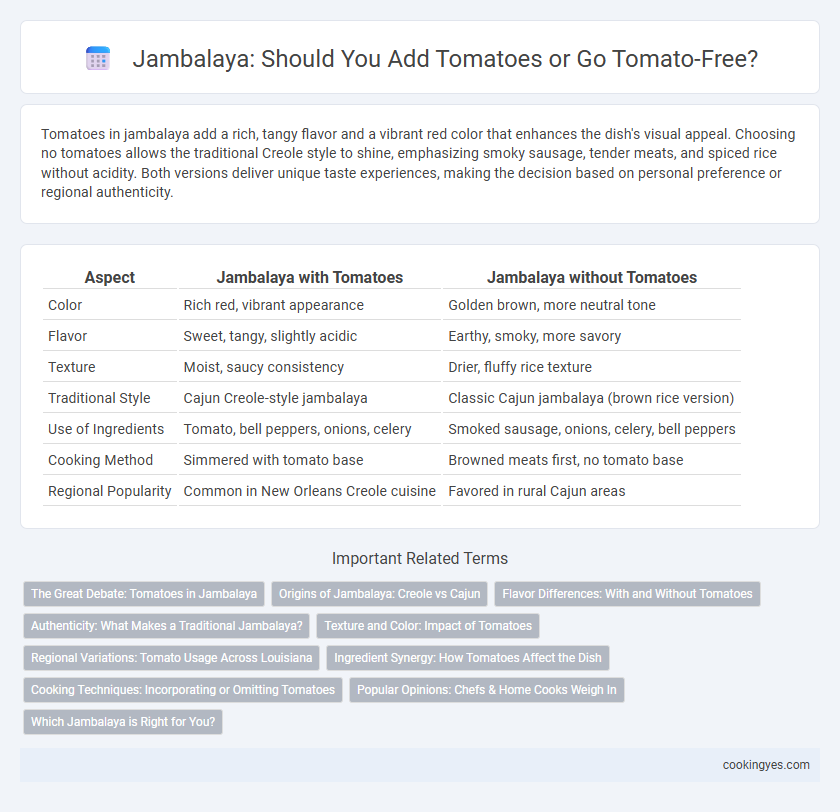Tomatoes in jambalaya add a rich, tangy flavor and a vibrant red color that enhances the dish's visual appeal. Choosing no tomatoes allows the traditional Creole style to shine, emphasizing smoky sausage, tender meats, and spiced rice without acidity. Both versions deliver unique taste experiences, making the decision based on personal preference or regional authenticity.
Table of Comparison
| Aspect | Jambalaya with Tomatoes | Jambalaya without Tomatoes |
|---|---|---|
| Color | Rich red, vibrant appearance | Golden brown, more neutral tone |
| Flavor | Sweet, tangy, slightly acidic | Earthy, smoky, more savory |
| Texture | Moist, saucy consistency | Drier, fluffy rice texture |
| Traditional Style | Cajun Creole-style jambalaya | Classic Cajun jambalaya (brown rice version) |
| Use of Ingredients | Tomato, bell peppers, onions, celery | Smoked sausage, onions, celery, bell peppers |
| Cooking Method | Simmered with tomato base | Browned meats first, no tomato base |
| Regional Popularity | Common in New Orleans Creole cuisine | Favored in rural Cajun areas |
The Great Debate: Tomatoes in Jambalaya
The Great Debate over tomatoes in jambalaya centers on regional preferences, with Creole jambalaya embracing tomatoes for a rich, tangy base while Cajun jambalaya typically excludes them, favoring a spicier, broth-driven flavor profile. Tomatoes add acidity and color, enhancing the dish's depth, but purists argue that traditional Cajun jambalaya relies on browned roux and smoked meats to achieve complexity without tomato's influence. This culinary divide highlights the broader cultural distinctions within Louisiana cuisine, where ingredient choices define beloved regional identities.
Origins of Jambalaya: Creole vs Cajun
Creole jambalaya, originating from New Orleans, traditionally includes tomatoes, reflecting French and Spanish influences in its rich, tomato-based sauce. Cajun jambalaya, rooted in rural Louisiana, omits tomatoes and relies on the "holy trinity" of onions, bell peppers, and celery for a more rustic, earthy flavor profile. The presence or absence of tomatoes distinctly marks the cultural and historical divide between Creole and Cajun culinary traditions.
Flavor Differences: With and Without Tomatoes
Jambalaya with tomatoes delivers a rich, tangy flavor profile that enhances the dish's depth and provides a slight sweetness balancing the spices. Without tomatoes, jambalaya maintains a cleaner, more savory taste, allowing the smoky sausage, seafood, or chicken flavors to dominate. The choice between tomatoes or no tomatoes ultimately shapes the overall taste, either highlighting zesty acidity or emphasizing intense, hearty seasoning.
Authenticity: What Makes a Traditional Jambalaya?
Traditional jambalaya is defined by its roots in Creole and Cajun cuisine, where the presence or absence of tomatoes distinguishes between the two styles; Creole jambalaya, often called "red jambalaya," incorporates tomatoes, while Cajun jambalaya omits them. Authentic Cajun jambalaya relies on a rich, smoky roux and a blend of spices, with meats like Andouille sausage, chicken, and seafood creating its bold flavor without tomato-based sauces. The choice between tomatoes or no tomatoes is a key factor in preserving the dish's regional authenticity and reflects the cultural heritage of Louisiana cooking.
Texture and Color: Impact of Tomatoes
Tomatoes in jambalaya add a rich, reddish hue and a slightly chunky texture that contrasts with the traditional smooth, rice-based consistency of the dish. Without tomatoes, jambalaya retains a lighter color and a more uniform, moist texture that highlights the smokiness of the sausage and the tenderness of the chicken or seafood. The choice between tomatoes or no tomatoes significantly influences the overall mouthfeel and visual appeal, shaping the dish's regional style and flavor profile.
Regional Variations: Tomato Usage Across Louisiana
In Louisiana, jambalaya recipes vary significantly between the Creole and Cajun regions, with Creole jambalaya traditionally incorporating tomatoes, giving it a rich, reddish hue and tangy flavor typical of New Orleans cuisine. Cajun jambalaya, originating from rural southwest Louisiana, typically excludes tomatoes, focusing on a deep, smoky profile with browned meats and smoky sausage. These regional differences in tomato usage highlight the diverse cultural influences that shape Louisiana's culinary landscape.
Ingredient Synergy: How Tomatoes Affect the Dish
Tomatoes introduce acidity and a subtle sweetness that balances the savory spices and smoky meat in jambalaya, enhancing the overall flavor complexity. Their moisture content helps meld the ingredients, creating a richer, more cohesive texture that complements the rice and proteins. Without tomatoes, the dish tends to have a drier, earthier profile, emphasizing the robust flavors of sausage and smoked meats without the bright contrast tomatoes provide.
Cooking Techniques: Incorporating or Omitting Tomatoes
In traditional Creole jambalaya, tomatoes contribute acidity and a rich, tangy flavor that balances the dish's spices, while Cajun versions often omit tomatoes to emphasize smoky, savory notes from browned meat and roux-based sauces. Incorporating tomatoes requires simmering them with the rice and protein to develop a cohesive, saucier texture, whereas omitting tomatoes calls for a drier cooking method that highlights caramelization and deep-seated umami. Choosing between tomatoes or no tomatoes shapes the jambalaya's overall flavor profile and cooking technique, influencing the dish's regional authenticity and consistency.
Popular Opinions: Chefs & Home Cooks Weigh In
Popular opinions among chefs and home cooks on Jambalaya often diverge when it comes to the inclusion of tomatoes. Traditional Creole jambalaya typically features tomatoes, adding a rich, tangy flavor and vibrant color, while Cajun-style jambalaya omits them, focusing on smoky, meaty depths with a brown rice base. This divide highlights the regional culinary influences and personal preferences that shape the iconic Louisiana dish.
Which Jambalaya is Right for You?
Choosing between tomato-based and non-tomato jambalaya depends on regional flavor preferences and dietary needs. Creole jambalaya features a rich tomato base with bell peppers and onions, offering a tangy, vibrant taste ideal for those seeking a zesty experience. Cajun jambalaya, on the other hand, is tomato-free, relying on smoked meats, spices, and broth to create a deeper, earthier flavor perfect for purists or those avoiding nightshades.
Tomatoes vs No Tomatoes for Jambalaya Infographic

 cookingyes.com
cookingyes.com